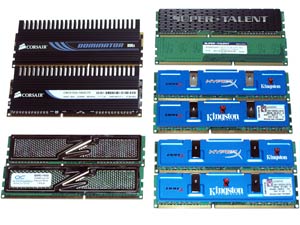DDR3 Memory Round-Up: Corsair, Kingston, OCZ, Super Talent
Intro and Corsair TWIN3X2048-1800C7DF

We're in the early stages of a major transition in the PC arena, much like in 2004 when Intel launched their first core logic chipset with support for DDR2 memory. This time around, however, Intel is pushing DDR3 memory with their current crop of desktop chipsets.
When DDR2 memory first hit the scene, we recommended users to tread lightly as the technology needed some time to mature. Back then DDR2 had much higher latency than standard DDR memory and it couldn't scale to high enough clock speeds to negate its latency disadvantages. And in many situations DDR2 memory actually performed below the bar set by standard DDR, not to mention it was much more expensive. In time though, DDR2 desktop memory scaled to well over 1GHz and its early latency disadvantage was erased by huge bandwidth gains. But it took quite a while for that to happen. In fact one could easily argue that the complete transition to DDR2 memory on the desktop took over two years and didn't happen until rival AMD introduced their socket AM2 platform in May of '06.
The landscape today is very different. There are some obvious parallels, but here we are only four months removed from the launch of Intel's P35 chipset - the first desktop chipset to support DDR3 memory - and already the market is rife with high-end memory kits that dramatically outperform the initial offerings that arrived alongside Intel's new platform. DDR3 memory kits are still substantially more expensive than even some of the fastest DDR2 kits, and they certainly don't represent the best value in desktop memory, but with the amount of innovation going on in this space we thought it was time to pull together a handful of fast DDR3 memory kits to see just what they could do.
We got our hands on five, dual-channel, 2GB kits from Corsair, Kingston (2), OCZ, and Super Talent each with different rated speeds and timings, ranging from 1333MHz to 1800MHz. Our intent is to show you how performance is affected by different clock speeds and timings using Intel's P35 chipset with a processor that has a 1333MHz front side bus speed.

10GB of DDR3: Corsair, OCZ, Super Talent and Kingston
|
|
|
"The Dominator Series TWIN3X2048-1800C7DF G is a 2048MByte kit of DDR3 SDRAM DIMMs built using Corsair’s latest high performance heat sink with Dual-path Heat Xchange (DHX) technology coupled with a Corsair Airflow Fan. This part delivers outstanding performance in the latest generation of dual-channel DDR3-based motherboards. It has been tested extensively in popular DDR3 motherboards to ensure compatibility and performance at its rated speed. This memory has been verified to operate at 1800MHz at latencies of 7-7-7-20 at 2.0V VDIMM."
|
Test Specifications:
|
Features:
|

Corsair's Flagship TWIN3X2048-1800C7DF DDR3-1800 Memory
 We've talked about Corsair's Dominator memory kits and their unique cooling in the past, so we'll paraphrase a bit here. Although based on DDR3 memory, the TWIN3X2048-1800C7DF kit shown here shares the same cooling technology as its DDR2-based Dominator branded counterparts. There are four key things at work in Corsair's Dominator memory kits that result in the product you see pictured above. With the Dominator series, the memory's PCB has been heightened and there are thermally conductive vias and traces running through the PCB and connected to the ground plane, to help dissipate heat from within the board itself. Heatsinks are then bonded to both sides of the upper portion of the PCB to further aid in heat dissipation.
We've talked about Corsair's Dominator memory kits and their unique cooling in the past, so we'll paraphrase a bit here. Although based on DDR3 memory, the TWIN3X2048-1800C7DF kit shown here shares the same cooling technology as its DDR2-based Dominator branded counterparts. There are four key things at work in Corsair's Dominator memory kits that result in the product you see pictured above. With the Dominator series, the memory's PCB has been heightened and there are thermally conductive vias and traces running through the PCB and connected to the ground plane, to help dissipate heat from within the board itself. Heatsinks are then bonded to both sides of the upper portion of the PCB to further aid in heat dissipation.
The memory chips on both sides of the PCB are outfitted with their own dedicated, oversized heatsinks to help cool the chips as well. Having two paths from which heat can be drawn out of the modules is what Corsair is calling DHX technology, or Dual-Path Heat Xchange. And the Dominator fan included with the kit is the third component that aids in cooling, which in turn enhances stability, longevity, and overclockability.
In addition to DHX, Corsair is aggressively binning the memory chips used on the Dominator kits and is using only select samples th at can operate reliably at their rated latencies and frequencies. The culmination of Corsair's efforts is a 2GB memory kit that's rated for operation at over 1.8GHz with 7-7-7-20 timings. We should note, however, that the TWIN3X2048-1800C7DF memory requires 2.0v to operate at its rated speed whereas many other DDR3 kits require only 1.7v to 1.8v.






